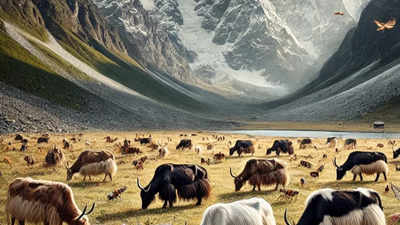Replacing wild herbivores with livestock hurting insects in Himalayas

BENGALURU: A 15-year study in India’s Spiti Valley revealed that replacing wild herbivores like yak and ibex with livestock such as cattle and sheep drastically affects ground-dwelling arthropods like spiders, as well as ticks and mites that can spread vector-borne diseases. The study found that areas grazed by livestock had greatly reduced spider populations and larger numbers of grasshoppers and disease carriers like ticks and mites, IISc said.
“Spiders are predators; their ecological roles are similar to wolves, lions, and tigers. A low abundance of spiders can release grasshoppers from predator control and lead to many downstream changes in an ecosystem. Together, these effects alter material and energy flow,” says Sumanta Bagchi, Associate Professor at IISc’s Centre for Ecological Sciences (CES), and corresponding author of the study published in Ecological Applications. Stating that wild herbivores were once ubiquitous across the Earth, Bagchi pointed out that now, they are restricted to a few parks and reserves.
“Everywhere else, domesticated animals are now dominant,” Bagchi, who along with his team tracked the presence of more than 25,000 arthropods spanning 88 different taxa, including spiders, ticks, mites, bees, wasps, and grasshoppers, in fenced plots grazed separately by domestic and wild herbivores, said. The team also analysed vegetation biomass and soil conditions like moisture and pH. “Vegetation and soil biotic and abiotic variables are intertwined in complex ways that we are still unravelling. Arthropods heavily depend on them for food and home, an association developed over centuries with native grazers in the ecosystem,” says Shamik Roy, former PhD student at CES and co-first author.
Replacing native grazers with livestock can disrupt this association. The team found that some arthropod numbers – specifically those of spiders, ticks, and mites – were strongly linked to which animal was grazing on the land. While spider numbers dropped under livestock grazing, tick and mite populations drastically increased. Although what exactly is causing the spider numbers to drop is not fully clear, the researchers suggest that it could be because of reduced food sources for spiders and changes in plant types in the area.
“One of the most surprising observations was the massive difference in tick and mite abundance between native grazers and livestock,” says Pronoy Baidya, former PhD student at CES and co-first author. According to the researchers, more than 80% of cattle around the world are estimated to harbour ticks that pose a threat to both animal and human health. “This is a major concern for zoonotic diseases and One Health,” Baidya adds.
To counter the consequences of these changes in arthropod numbers, researchers suggest steps towards “rewilding” native herbivores and improved surveillance of vector-borne disease risks in areas where animals and humans coexist. The findings also underscore the need for effective conservation policies in areas where large-scale grazing by livestock is carried out. Currently, Baidya said, most of the commons are rather mismanaged, allowing people from villages to unsustainably utilise these commons for their livelihoods, and in the process denying the local herbivores their grazing areas.
“Our study will hopefully be an example which may nudge govts to take serious steps for freeing up the commons first and then starting proper ecological restoration of these lands,” Baidya added.
















